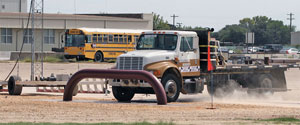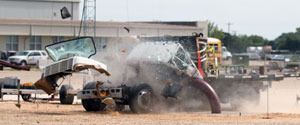How do you keep a terrorist from bombing an embassy with a fast-moving car or truck fitted with explosives? The terrorist tactic goes back more than 30 years when the U.S. Marine barracks were bombed in Beirut, Lebanon. Today, embassies, consulates, and other facilities and bases here and abroad are protected with bollards and other protective barricades — many of them developed and tested at the Texas A&M Transportation Institute (TTI).




“We have been working with the U.S. Department of State since 2001 developing various devices like bollards and wedges, all designed to keep vehicles from entering a facility,” TTI Associate Research Engineer William Williams says. Williams designed the latest perimeter security device, which was tested at TTI’s Proving Grounds facility September 24.
Although the existing devices being used now work well, there have been some issues related to installation, especially in third-world countries.
“We need a device that not only is more aesthetically pleasing, but one that does not interfere with underground utilities, which are sometimes buried less than 2 feet deep,” says Russell Norris, a State Department engineer with the Bureau of Diplomatic Security’s Physical Security Division.
Although the so-called bent pipe design seems simple enough, it had to meet State Department requirements and stop a 15,000-pound truck traveling at 50 miles per hour. The test would only be a success if the truck bed did not go more than 1 meter past the barrier.
The new design is a 12-inch-diameter pipe made of 1-inch-thick steel that spans 15 feet in length and is 42 inches tall. The two ends of the pipe are placed in a foundation 18 inches thick and surrounded by 10,000 pounds of concrete. The weight of the whole system is about 50,000 pounds.
The unclassified crash test, which lasted less than a minute, was viewed by State Department officials, researchers and media representatives. When the truck slammed into the barrier, the impact of the collision was so great it forced the truck’s engine into the cab. The bed crashed forward into the cab from the other direction. In slow-motion video, you can see the barrier and its foundation lift slightly but quickly settle back into place. The truck’s frame and front tires went underneath the top of the pipe, stopping a few feet past the barrier. But the bed, loaded with 50-gallon barrels, was prevented from entering the protected area. Video of the crash was aired on news websites and quickly spread to international publications.
“We’ve conducted about 150 crash tests of anti-ram and anti-terrorist perimeter barriers, fences and gates for the State Department,” says Dean Alberson, TTI assistant agency director and program manager for the Institute’s Crashworthy Structures Program. “This one seemed particularly dramatic, especially watching the debris field in the slow-motion version of the video.” Alberson helped initiate a five-year cooperative agreement with the State Department in 2010.
“One of the biggest accomplishments we’ve had working with TTI is the barrier system that addressed some of the shortcomings we saw in the commercial sector,” Norris says. “A lot of effort went into harmonizing our standards with the United Kingdom’s vehicle crash standards and the ISO [International Organization for Standardization] to harmonize vehicle barrier crash protocols and procedures.”


